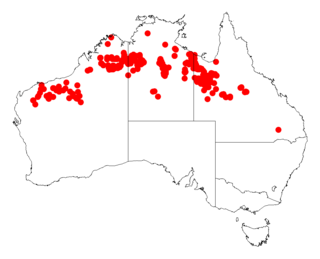
Acacia coriacea, commonly known as river jam, wirewood, desert oak, wiry wattle or dogwood, is a tree in the family Mimosoideae of family Fabaceae. Indigenous Australians know the plant as Gunandru.

Acacia sclerosperma, commonly known as limestone wattle or silver bark wattle, is a tree in the family Fabaceae. Endemic to Western Australia, it occurs on floodplains and along water-courses throughout the arid north-west corner of the State.

Acacia terminalis is a shrub or small tree to 6 m in height. It's an Australian native whose range extends through New South Wales, Victoria and Tasmania.

Acacia deanei is a tree native to Australia, which is useful for controlling soil erosion. There are two subspecies: Acacia deanei subsp. deanei and Acacia deanei subsp. paucijuga.
Acacia coriacea subsp. coriacea is a subspecies of Acacia coriacea that occurs in Western Australia and the Northern Territory.
Acacia coriacea subsp. sericophylla is a shrub or tree growing 2 m to 10 m high. This subspecies of Acacia coriacea, sometimes considered a full species, is endemic to northern Australia. It flowers all year. Its flowers are light yellow to cream-colored.

Acacia holosericea, is a shrub native to tropical and inland northern Australia. It is commonly known as soapbush wattle, soapbush, strap wattle, candelabra wattle, silver wattle and silky wattle.

Acacia moirii, commonly known as Moir's wattle, is a subshrub which is endemic to the south-west of Western Australia. It grows to between 0.15 and 0.6 metres high and has densely hairy leaflets. The globular golden-yellow flower heads appear from May to August, followed by hairy seed pods which are around 4 cm long and 5 to 6 mm wide.

Vachellia is a genus of flowering plants in the legume family, Fabaceae, commonly known as thorn trees or acacias. It belongs to the subfamily Mimosoideae. Its species were considered members of genus Acacia until 2009. Vachellia can be distinguished from other acacias by its capitate inflorescences and spinescent stipules. Before discovery of the New World, Europeans in the Mediterranean region were familiar with several species of Vachellia, which they knew as sources of medicine, and had names for them that they inherited from the Greeks and Romans.

Acacia bivenosa, commonly known as two-nerved wattle, two-veined wattle or hill umbrella bush, is a species of Acacia found in northern Australia.

Acacia mucronata, the variable sallow wattle or narrow-leaved wattle, is a shrub or small tree to 5 m high. It is native to southeast Australia, mainly the states of Tasmania and Victoria. It often grows as an understorey tree or shrub in eucalypt forest or as a dominant in scrubland. In drier regions of its distribution, like in northeast Tasmania, it often grows along creeks and sheltered coastlines.

Acacia ancistrocarpa, commonly known as fitzroy wattle, is a shrub belonging to the genus Acacia and the subgenus Juliflorae. The shrub is also known as fish hook wattle, pindan wattle and shiny leaved wattle.

Acacia catenulata, commonly known as bendee, is a tree belonging to the genus Acacia and the subgenus Juliflorae that is endemic to some arid areas in Australia.

Acacia tenuissima, commonly known as narrow-leaved wattle, broom wattle, minyana, slender mulga or slender wattle, is a shrub belonging to the genus Acacia and the subgenus Juliflorae endemic to temperate and tropical areas of Australia. Indigenous Australians the Kurrama peoples know the plant as Janangungu and the Banyjima know it as Murruthurru.

Acacia trachycarpa, commonly known as minni ritchi, curly-bark tree, sweet-scented minni ritchi or Pilbara minni ritchi, is a shrub or tree belonging to the genus Acacia and the subgenus Juliflorae that is native to arid and semi-arid areas of Western Australia.

Acacia retivenea, commonly known as the net-veined wattle, is a shrub of the genus Acacia and the subgenus Plurinerves that is endemic across northern Australia.

Acacia sericophylla is a shrub or tree commonly known as the desert dogwood, desert oak or cork-bark wattle. To the Indigenous Australian people of the Pilbara, the Nyangumarta peoples, it is known as Pirrkala. The species is of the genus Acacia and the subgenus Plurinerves.

Acacia macdonnelliensis, commonly known as the MacDonnell mulga or the Hill mulga, is a species of Acacia native to central Australia. The Indigenous Australians the Alyawarr peoples know the plant as irrar, the Kaytetye know it as arleth-arlethe or arwele arleth-arlethe and the Western Arrernte peoples know it as irrkwarteke.
Acacia exilis, commonly known as muntalkura wattle, is a species of wattle belonging to the genus Acacia and the subgenus Juliflorae. The Kurrama peoples know the tree as jonanyong or jananyung. It is native to an area of the Pilbara region of Western Australia.















